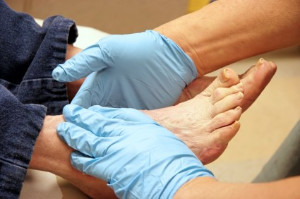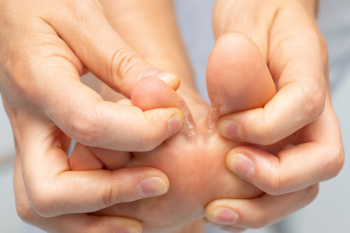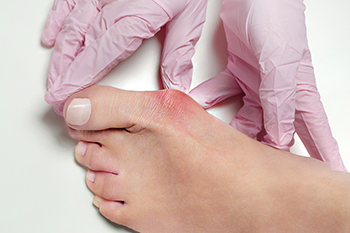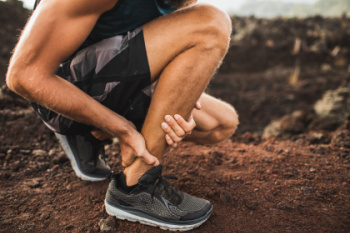Connect With Us
Blog
Items filtered by date: June 2025
Caring for Diabetic Feet Starts with Everyday Awareness

Diabetes can affect how the feet feel, heal, and function, which is why they need daily attention. Numbness may prevent small injuries from being noticed, and reduced blood flow can slow healing. Simple steps like inspecting feet each day, wearing properly fitted shoes, and keeping the skin clean and moisturized help lower the risk of complications. Gentle nail care and avoiding walking barefoot are also key. Staying active supports circulation, and keeping blood sugar levels in range helps protect nerves and tissues. Despite careful routines, changes can still happen. Signs such as lingering sores, unusual redness, or sudden discomfort deserve professional attention. If your feet are showing new or concerning symptoms, it is suggested that you schedule an appointment with a podiatrist for a diagnosis and appropriate treatment.
Diabetic foot care is important in preventing foot ailments such as ulcers. If you are suffering from diabetes or have any other concerns about your feet, contact Emil Babayev, DPM from New York. Our doctor can provide the care you need to keep you pain-free and on your feet.
Diabetic Foot Care
Diabetes affects millions of people every year. The condition can damage blood vessels in many parts of the body, especially the feet. Because of this, taking care of your feet is essential if you have diabetes, and having a podiatrist help monitor your foot health is highly recommended.
The Importance of Caring for Your Feet
- Routinely inspect your feet for bruises or sores.
- Wear socks that fit your feet comfortably.
- Wear comfortable shoes that provide adequate support.
Patients with diabetes should have their doctor monitor their blood levels, as blood sugar levels play such a huge role in diabetic care. Monitoring these levels on a regular basis is highly advised.
It is always best to inform your healthcare professional of any concerns you may have regarding your feet, especially for diabetic patients. Early treatment and routine foot examinations are keys to maintaining proper health, especially because severe complications can arise if proper treatment is not applied.
If you have any questions, please feel free to contact our offices located in Midwood and Kensington in Brooklyn, NY . We offer the newest diagnostic and treatment technologies for all your foot care needs.
Understanding Athlete's Foot

Athlete's foot is a fungal infection that affects the skin on the feet, often between the toes. There are three main types of athlete's foot infections. Interdigital occurs between the toes, moccasin forms on the soles and sides of the feet, and vesicular includes blister-like lesions. Athlete’s foot is caused by a fungus that thrives in warm, moist environments, such as sweaty shoes or communal shower areas. Symptoms include itching, burning, redness, and cracking of the skin. In some cases, blisters may form, and the skin can become thick and flaky. The infection is contagious and can spread to other areas of the body or to other people. A podiatrist can diagnose athlete's foot through a physical exam and may take a skin sample to confirm the presence of fungus. Treatment typically involves antifungal creams, powders, or oral medication, along with advice on proper foot hygiene and footwear. If you have this condition, it is suggested that you schedule an appointment with a podiatrist for effective treatment and prevention strategies.
Athlete’s Foot
Athlete’s foot is often an uncomfortable condition to experience. Thankfully, podiatrists specialize in treating athlete’s foot and offer the best treatment options. If you have any questions about athlete’s foot, consult with Emil Babayev, DPM from New York. Our doctor will assess your condition and provide you with quality treatment.
What Is Athlete’s Foot?
Tinea pedis, more commonly known as athlete’s foot, is a non-serious and common fungal infection of the foot. Athlete’s foot is contagious and can be contracted by touching someone who has it or infected surfaces. The most common places contaminated by it are public showers, locker rooms, and swimming pools. Once contracted, it grows on feet that are left inside moist, dark, and warm shoes and socks.
Prevention
The most effective ways to prevent athlete’s foot include:
- Thoroughly washing and drying feet
- Avoid going barefoot in locker rooms and public showers
- Using shower shoes in public showers
- Wearing socks that allow the feet to breathe
- Changing socks and shoes frequently if you sweat a lot
Symptoms
Athlete’s foot initially occurs as a rash between the toes. However, if left undiagnosed, it can spread to the sides and bottom of the feet, toenails, and if touched by hand, the hands themselves. Symptoms include:
- Redness
- Burning
- Itching
- Scaly and peeling skin
Diagnosis and Treatment
Diagnosis is quick and easy. Skin samples will be taken and either viewed under a microscope or sent to a lab for testing. Sometimes, a podiatrist can diagnose it based on simply looking at it. Once confirmed, treatment options include oral and topical antifungal medications.
If you have any questions, please feel free to contact our offices located in Midwood and Kensington in Brooklyn, NY . We offer the newest diagnostic and treatment technologies for all your foot care needs.
Are You Suffering From Ingrown Toenails?
Treatment and Complications of Bunions

A bunion is a bony growth that develops at the base of the big toe when the joint becomes misaligned. Bunions are often the result of inherited foot structure problems, such as flat feet or joint looseness. Over time, the top of the toe leans inward, causing pain, swelling, and difficulty walking. Bunions can lead to complications, if ignored. Bursitis, which is inflammation of the joint's fluid-filled sac, may develop and cause additional pain and stiffness. Other complications include hammertoes, overlapping toes, metatarsal pain, and thickened skin or calluses. In certain cases, joint damage can limit motion in the big toe or result in permanent deformity. A podiatrist can assess the severity of the bunion and determine the most appropriate care. Treatment options include custom orthotics to relieve pressure or bunion surgery to realign the bones and remove inflamed tissue. If you have painful bunions, it is suggested that you schedule an appointment with a podiatrist for an exam and appropriate treatment options.
If you are suffering from bunions, contact Emil Babayev, DPM of New York. Our doctor can provide the care you need to keep you pain-free and on your feet.
What Is a Bunion?
A bunion is formed of swollen tissue or an enlargement of boney growth, usually located at the base joint of the toe that connects to the foot. The swelling occurs due to the bones in the big toe shifting inward, which impacts the other toes of the foot. This causes the area around the base of the big toe to become inflamed and painful.
Why Do Bunions Form?
Genetics – Susceptibility to bunions are often hereditary
Stress on the feet – Poorly fitted and uncomfortable footwear that places stress on feet, such as heels, can worsen existing bunions
How Are Bunions Diagnosed?
Doctors often perform two tests – blood tests and x-rays – when trying to diagnose bunions, especially in the early stages of development. Blood tests help determine if the foot pain is being caused by something else, such as arthritis, while x-rays provide a clear picture of your bone structure to your doctor.
How Are Bunions Treated?
- Refrain from wearing heels or similar shoes that cause discomfort
- Select wider shoes that can provide more comfort and reduce pain
- Anti-inflammatory and pain management drugs
- Orthotics or foot inserts
- Surgery
If you have any questions, please feel free to contact our offices located in Midwood and Kensington in Brooklyn, NY . We offer the newest diagnostic and treatment technologies for all your foot care needs.
Achilles Tendon Rupture Can Lead to an Ankle Fracture

A sudden rupture of the achilles tendon is a serious injury that can sometimes be linked to an ankle fracture. The achilles tendon connects the calf muscles to the heel bone and helps with walking, running, and jumping. When it tears, the force involved can be strong enough to stress the surrounding bones and joints. In certain cases, this trauma may cause small fractures near the ankle, especially if the foot is planted or twisted during the injury. Pain, swelling, bruising, and difficulty in walking are common signs of both injuries. Because the symptoms can overlap, imaging is often needed to confirm a fracture. Healing from both a rupture and a fracture may involve immobilization, targeted exercises, or surgery. If you experience a sudden pop in your heel followed by severe pain or swelling, it is suggested that you see a podiatrist for a proper diagnosis and appropriate treatment.
Achilles tendon injuries need immediate attention to avoid future complications. If you have any concerns, contact Emil Babayev, DPM of New York. Our doctor can provide the care you need to keep you pain-free and on your feet.
What Is the Achilles Tendon?
The Achilles tendon is a tendon that connects the lower leg muscles and calf to the heel of the foot. It is the strongest tendon in the human body and is essential for making movement possible. Because this tendon is such an integral part of the body, any injuries to it can create immense difficulties and should immediately be presented to a doctor.
What Are the Symptoms of an Achilles Tendon Injury?
There are various types of injuries that can affect the Achilles tendon. The two most common injuries are Achilles tendinitis and ruptures of the tendon.
Achilles Tendinitis Symptoms
- Inflammation
- Dull to severe pain
- Increased blood flow to the tendon
- Thickening of the tendon
Rupture Symptoms
- Extreme pain and swelling in the foot
- Total immobility
Treatment and Prevention
Achilles tendon injuries are diagnosed by a thorough physical evaluation, which can include an MRI. Treatment involves rest, physical therapy, and in some cases, surgery. However, various preventative measures can be taken to avoid these injuries, such as:
- Thorough stretching of the tendon before and after exercise
- Strengthening exercises like calf raises, squats, leg curls, leg extensions, leg raises, lunges, and leg presses
If you have any questions please feel free to contact our offices located in Midwood and Kensington in Brooklyn, NY . We offer the newest diagnostic tools and technology to treat your foot and ankle needs.

